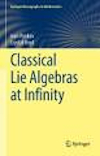- About MAA
- Membership
- MAA Publications
- Periodicals
- Blogs
- MAA Book Series
- MAA Press (an imprint of the AMS)
- MAA Notes
- MAA Reviews
- Mathematical Communication
- Information for Libraries
- Author Resources
- Advertise with MAA
- Meetings
- Competitions
- Programs
- Communities
- MAA Sections
- SIGMAA
- MAA Connect
- Students
- MAA Awards
- Awards Booklets
- Writing Awards
- Teaching Awards
- Service Awards
- Research Awards
- Lecture Awards
- Putnam Competition Individual and Team Winners
- D. E. Shaw Group AMC 8 Awards & Certificates
- Maryam Mirzakhani AMC 10 A Awards & Certificates
- Two Sigma AMC 10 B Awards & Certificates
- Jane Street AMC 12 A Awards & Certificates
- Akamai AMC 12 B Awards & Certificates
- High School Teachers
- News
You are here
Classical Lie Algebras at Infinity

Publisher:
Springer
Publication Date:
2022
Number of Pages:
252
Format:
Hardcover
Price:
139.99
ISBN:
978-3-030-89659-1
Category:
Monograph
[Reviewed by , on ]
Mark Hunacek
08/1/2022
Although this book has some of the trappings of a text (e.g., exercises and clear exposition), and originated from upper-level graduate courses taught by the first author, it is primarily addressed to an audience of researchers: people who are, or aspire to be, specialists in the area of locally reductive infinite-dimensional Lie algebras and superalgebras. This is, of course, rather technical stuff, but the book is designed to not only serve as a reference but also to introduce well-prepared people to the subject and its current areas of inquiry.
A reader does, however, have to be well-prepared. Indeed, a working knowledge of the standard theory of Lie algebras and their representations is an essential prerequisite for the book. Prior knowledge of Lie superalgebras may not be a technical prerequisite (while the term “Lie algebra” is not defined in the text, the term “Lie superalgebra” is) but would certainly stand a reader in good stead. At the beginning of chapter 1, the authors cite Bourbaki’s Lie Groups and Lie Algebras as an “ideal basic reference” and source for proofs, so we know from the outset the level of sophistication a reader is expected to bring to this book. To illustrate, the first chapter reviews the classical Lie algebras, Cartan and Borel subalgebras, and root systems, all in less than seven pages, so cannot really serve as a substitute for prior knowledge of this material.
Some specific chapters have additional prerequisites, including prior background in homological algebra (chapters 7 and 9) and algebraic geometry, algebraic groups and sheaf cohomology (chapter 10).
There are ten chapters. The first six (Part I of the text) are prefatory to the last four and discuss the general structure theory of locally reductive Lie algebras and superalgebras. In the first four chapters, the authors first provide, as noted above, a very quick summary of the structure theory of the classical (complex) Lie algebras, and then discuss, not quite so quickly, Lie superalgebras, and locally reductive Lie algebras and superalgebras. The fifth and sixth chapters look at some very important specific examples and discuss their structure theory by examining their Borel and Cartan subalgebras.
The last four chapters, which bring us to the frontiers of current research in the area, constitute Parts II and III of the text. Part II (chapters 7 – 9) discusses aspects of module theory and representation theory. The remaining chapter, Part III of the text, introduces geometrical considerations and discusses analogs of the classical Bott-Borel-Weil theorem of geometric representation theory.
So, to summarize and conclude: it seems fair to say that this book will appeal to a somewhat narrower subset of readers of this column than do many of the books reviewed here. But the people in this subset should find this a useful, in the authors’ words, “invitation to a wide open research area”.
Mark Hunacek (mhunacek@iastate.edu) is a Teaching Professor Emeritus at Iowa State University.
See the publisher's website.
- Log in to post comments




